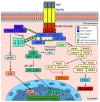Tumour necrosis factor signalling in health and disease
- PMID: 30755793
- PMCID: PMC6352924
- DOI: 10.12688/f1000research.17023.1
Tumour necrosis factor signalling in health and disease
Abstract
The master pro-inflammatory cytokine, tumour necrosis factor (TNF), has been shown to modulate multiple signalling pathways, with wide-ranging downstream effects. TNF plays a vital role in the typical immune response through the regulation of a number of pathways encompassing an immediate inflammatory reaction with significant innate immune involvement as well as cellular activation with subsequent proliferation and programmed cell death or necrosis. As might be expected with such a broad spectrum of cellular effects and complex signalling pathways, TNF has also been implicated in a number of disease states, such as rheumatoid arthritis, ankylosing spondylitis, and Crohn's disease. Since the time of its discovery over 40 years ago, TNF ligand and its receptors, TNF receptor (TNFR) 1 and 2, have been categorised into two complementary superfamilies, namely TNF (TNFSF) and TNFR (TNFRSF), and 19 ligands and 29 receptors have been identified to date. There have been significant advances in our understanding of TNF signalling pathways in the last decade, and this short review aims to elucidate some of the most recent advances involving TNF signalling in health and disease.
Keywords: Autoinflammatory; Cell death; Immunometabolism; TNF; TNFR.
Conflict of interest statement
No competing interests were disclosed.No competing interests were disclosed.No competing interests were disclosed.
Figures


Similar articles
-
TNF and TNFR biology in health and disease.Cell Mol Biol (Noisy-le-grand). 2001 Jun;47(4):619-35. Cell Mol Biol (Noisy-le-grand). 2001. PMID: 11502070 Review.
-
Interactions between TNF and GnRH.Neurochem Res. 2008 Apr;33(4):678-82. doi: 10.1007/s11064-007-9505-8. Epub 2007 Nov 6. Neurochem Res. 2008. PMID: 17985235 Review.
-
The TNF Family of Ligands and Receptors: Communication Modules in the Immune System and Beyond.Physiol Rev. 2019 Jan 1;99(1):115-160. doi: 10.1152/physrev.00045.2017. Physiol Rev. 2019. PMID: 30354964 Review.
-
The role of the two TNF receptors in proliferation, NF-kappa B activation and discrimination between TNF and LT alpha signalling in the human myeloma cell line OH-2.Cytokine. 1996 Jun;8(6):430-8. doi: 10.1006/cyto.1996.0059. Cytokine. 1996. PMID: 8818539
-
TNF receptor subtype signalling: differences and cellular consequences.Cell Signal. 2002 Jun;14(6):477-92. doi: 10.1016/s0898-6568(01)00262-5. Cell Signal. 2002. PMID: 11897488 Review.
Cited by
-
Tumor Necrosis Factor-Alpha: Ally and Enemy in Protean Cutaneous Sceneries.Int J Mol Sci. 2024 Jul 16;25(14):7762. doi: 10.3390/ijms25147762. Int J Mol Sci. 2024. PMID: 39063004 Free PMC article. Review.
-
Analysis of circulating-microRNA expression in lactating Holstein cows under summer heat stress.PLoS One. 2020 Aug 31;15(8):e0231125. doi: 10.1371/journal.pone.0231125. eCollection 2020. PLoS One. 2020. PMID: 32866172 Free PMC article.
-
Ebosin Attenuates the Inflammatory Responses Induced by TNF-α through Inhibiting NF-κB and MAPK Pathways in Rat Fibroblast-Like Synoviocytes.J Immunol Res. 2022 Mar 17;2022:9166370. doi: 10.1155/2022/9166370. eCollection 2022. J Immunol Res. 2022. PMID: 35340587 Free PMC article.
-
TNF-α contributes to sarcopenia through caspase-8/caspase-3/GSDME-mediated pyroptosis.Cell Death Discov. 2023 Feb 24;9(1):76. doi: 10.1038/s41420-023-01365-6. Cell Death Discov. 2023. PMID: 36823174 Free PMC article.
-
Compartment-driven imprinting of intestinal CD4 T cells in inflammatory bowel disease and homeostasis.Clin Exp Immunol. 2023 Dec 13;214(3):235-248. doi: 10.1093/cei/uxad095. Clin Exp Immunol. 2023. PMID: 37565620 Free PMC article.
References
Publication types
MeSH terms
Substances
LinkOut - more resources
Full Text Sources
Other Literature Sources
Molecular Biology Databases
Research Materials

